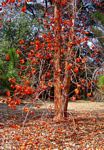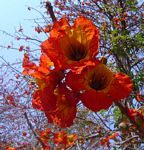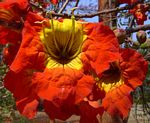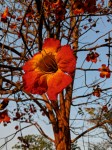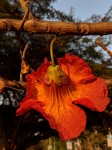Fernandoa abbreviata
Selected images: Click on each image to see a larger version and details of the record View all images (8)
Detailed records: Display species records QDS maps by: Google Maps Point records by Google Maps
Species details: Click on each item to see an explanation of that item (Note: opens a new window)
| Synonyms: | |
| Common names: | |
| Frequency: | |
| Status: | Native |
| Description: |
Tree to 18 m. Bark reddish-brown, vertically striate. Leaves with 3-5 pairs of leaflets and a terminal leaflet; leaflets oblong to elliptic; margin sinuate to serrate. Flowers borne singly or in few-flowered racemes, spectacular, bright orange-red with a yellow centre. Calyx 2-3-lobed. Corolla bell-shaped, up to 10 cm in diameter, shallowly lobed with 4 large stamens and a shorter staminode; anther thecae 5-8 mm long. Fruit a long slender capsule, to 60 cm long, ± circular in cross-section. |
| Type location: |
|
| Notes: | For a discussion of this species, see F. magnifica. |
| Derivation of specific name: | abbreviata: shortened (probably referring to the inflorescence) |
| Habitat: | Dry woodland on rocky slopes and in dry montane forest |
| Altitude range: (metres) | 700 - 1370 m |
| Flowering time: | Jun - Oct |
| Worldwide distribution: | Central Tanzania (Iringa, Mpwapwa and (?) Morogoro Districts) and southern Malawi (Mulanje District). |
| FZ divisions: | S |
| Growth form(s): | Tree. |
| Endemic status: | |
| Red data list status: | |
| Insects associated with this species: | |
| Spot characters: | Display spot characters for this species |
| Literature: |
Bidgood, S (1994). Synopsis of the Continental African Species of Fernandoa (Bignoniaceae) Kew Bulletin 49(3) Pages 386 - 388. (Includes a picture). |
Other sources of information about Fernandoa abbreviata:
Our websites:
Flora of Zimbabwe: cultivated Fernandoa abbreviataExternal websites:
African Plants: A Photo Guide (Senckenberg): Fernandoa abbreviataAfrican Plant Database: Fernandoa abbreviata
BHL (Biodiversity Heritage Library): Fernandoa abbreviata
EOL (Encyclopedia of Life): Fernandoa abbreviata
GBIF (Global Biodiversity Information Facility): Fernandoa abbreviata
Google: Web - Images - Scholar
iNaturalist: Fernandoa abbreviata
IPNI (International Plant Names Index): Fernandoa abbreviata
JSTOR Plant Science: Fernandoa abbreviata
Mansfeld World Database of Agricultural and Horticultural Crops: Fernandoa abbreviata
Plants of the World Online: Fernandoa abbreviata
Tropicos: Fernandoa abbreviata
Wikipedia: Fernandoa abbreviata

